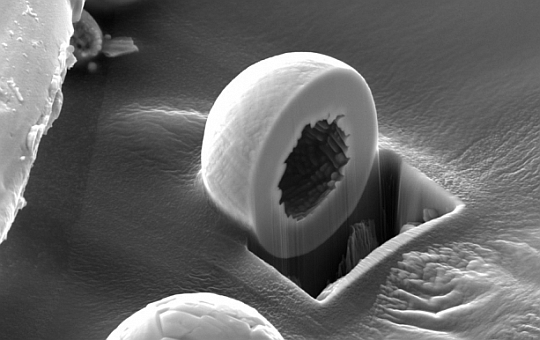The Focused Ion Beam (FIB) Systems Market is projected to grow from USD 1,687.34 million in 2023 to USD 3,154.68 million by 2032, reflecting a compound annual growth rate (CAGR) of 7.20%.The global Focused Ion Beam (FIB) systems market has witnessed significant growth in recent years, driven by advancements in nanotechnology, materials science, and semiconductor manufacturing. These sophisticated systems are crucial for applications ranging from circuit editing and failure analysis to sample preparation and nano-scale patterning. As industries increasingly demand precision at the nanoscale, the importance of FIB systems is set to expand further.
Browse the full report at https://www.credenceresearch.com/report/focused-ion-beam-fib-systems-market
Market Overview
Focused Ion Beam systems are specialized instruments that use a beam of ions, typically gallium, to image, modify, or analyze materials at the nanoscale. These systems have become indispensable tools in a variety of fields, including electronics, materials science, and biology, due to their versatility in machining and characterizing samples with high precision.
The global FIB market is driven by the growing need for miniaturization in electronics and the increasing complexity of semiconductor devices. As the semiconductor industry pushes towards smaller and more efficient components, the demand for tools that can manipulate and analyze materials at the atomic level has surged. Additionally, the rise in nanotechnology applications across various sectors, including healthcare and energy, has further fueled the growth of the FIB systems market.
Key Market Drivers
1. Advancements in Semiconductor Technology: The semiconductor industry is a major driver of the FIB systems market. As the demand for smaller, faster, and more efficient electronic devices increases, semiconductor manufacturers are increasingly relying on FIB systems for tasks such as defect analysis, circuit modification, and device characterization. The continuous shrinking of semiconductor nodes, with technologies moving towards 7nm, 5nm, and even smaller nodes, necessitates the use of FIB systems for precise material removal and analysis at these scales.
2. Growing Applications in Nanotechnology: FIB systems are integral to the advancement of nanotechnology. These systems are used for the fabrication of nano-scale structures, which are essential for the development of new materials and devices. In addition to semiconductor applications, FIB systems are used in the creation of nanostructures for use in sensors, medical devices, and energy storage systems. The ability to precisely manipulate materials at the atomic level makes FIB systems invaluable in these emerging fields.
3. Increased Demand in Failure Analysis: FIB systems are critical tools in failure analysis, particularly in the semiconductor and electronics industries. As devices become more complex, the need for precise and accurate analysis of failures increases. FIB systems allow engineers to pinpoint defects and make modifications at the microscopic level, which is crucial for improving product reliability and reducing time-to-market.
Challenges and Restraints
Despite the promising growth prospects, the FIB systems market faces several challenges. One of the primary constraints is the high cost of these systems. The sophisticated technology and precision required in FIB systems make them expensive to purchase and maintain, limiting their adoption to well-funded research institutions and large industrial players.
Another challenge is the complexity of FIB operation. These systems require skilled operators to achieve the desired results, and there is a shortage of trained professionals in the field. The learning curve associated with FIB systems can be steep, which may slow down the adoption rate in some industries.
Future Outlook
The future of the FIB systems market looks promising, with continued growth expected as industries increasingly rely on nanoscale precision. Advances in FIB technology, such as the development of new ion sources and improved imaging capabilities, are likely to expand the range of applications for these systems. Moreover, the integration of FIB systems with other technologies, such as electron microscopy and 3D printing, could open up new opportunities in materials science, electronics, and biotechnology.
Key Player Analysis
- Thermo Fisher Scientific, Inc.
- Hitachi High-Technologies Corporation
- Carl Zeiss AG
- JEOL Ltd.
- Evans Analytical Group
- Fibics, Inc.
- TESCAN ORSAY HOLDING a.s.
- Raith GmbH
- Zerok Nano Tech Corporation
Segments:
Based on Source:
- Liquid Metal Ion Source
- Gas Field Ion Source
- Plasma Ion Source
Based on Application:
- Quality Control & Failure Analysis
- Market Analysis
- Semiconductor Device Packaging
- Nano-micro-Patterning
- Others
Based on End-user:
- Material Science
- Life Science
- Electronics & Semiconductors
- Research & Academia
- Others
Based on the Geography:
- North America
- US
- Canada
- Mexico
- Europe
- Germany
- France
- UK
- Italy
- Spain
- Rest of Europe
- Asia Pacific
- China
- Japan
- India
- South Korea
- South-east Asia
- Rest of Asia Pacific
- Latin America
- Brazil
- Argentina
- Rest of Latin America
- Middle East & Africa
- GCC Countries
- South Africa
- Rest of Middle East and Africa
Browse the full report at https://www.credenceresearch.com/report/focused-ion-beam-fib-systems-market
About Us:
Credence Research is committed to employee well-being and productivity. Following the COVID-19 pandemic, we have implemented a permanent work-from-home policy for all employees.
Contact:
Credence Research
Please contact us at +91 6232 49 3207
Email: sales@credenceresearch.com
Website: www.credenceresearch.com
